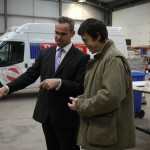partnership in outdoor learning
Rory visited Low Luckens Organic Resource Centre on Friday and called for closer partnerships between farms, schools, colleges and the voluntary sector on outdoor learning. Low Luckens, an industrial and provident society founded in 2000, educates the public in wildlife, renewable energy, sustainable farming and nature conservation. Rory visited the organic farm and its associated business Eva’s Organics, joined an outdoor lesson with students from a Carlisle school, and met staff and Trustees of the centre
Rory said: “We work to bring projects like this closer together across Cumbria. Low Luckens is doing fantastic work with 40 school visits every year but there is so much more potential. I would like to see the new leadership at Newton Rigg work more closely with Low Luckens on apprenticeships and courses. There is also a great opportunity for a partnership with Cumbria’s National Citizen Service pilot. I will be encouraging Newton Rigg, Outward Bound, Connexions Cumbria and schools to find more ways of working together and linking our unique landscape to education. There are also real economic opportunities here: whether it is in Eva’s Organics’ work with the Brampton Food Network or the proposal to build an anaerobic digester for renewable energy. Farming around Bewcastle and Roadhead is some of the toughest farming in the country: it is great to see a farmer making so much out of his land to benefit people not only in food production but also in education.”
Rory also enjoyed participating in the Centre’s school visit, and took part in an insect-finding session with children.
Committee member Mike Downham said: “We were delighted when our local MP – Rory Stewart – took the time out of his very busy schedule to visit us on Friday, 6 May at the Low Luckens Organic Resource Centre. We were even more delighted when he joined in with a primary school educational visit and got involved “hands-on” with a mini-beast hunt in the woods at Low Luckens. The Centre specialises in educational visits that connect adults and children with the food they eat and the countryside. It uses the 200 acre working organic upland farm as an outdoor classroom. The Centre has been successful over the past 10 years because it too continues to learn. We were, therefore, pleased to get Rory’s support to develop and strengthen our links with Newton Rigg and to explore with Connections a role in National Citizen Service. This will help us deliver our aims to increase Higher Education activity and to increase volunteering opportunities”.ENDS
Picture below: Left to right: LLORC Committee member Mike Downham, Rory Stewart MP, LLORC Chair Hazel Broatch, LLORC Committee member Peter Ryan, Centre Manager Jill Jones, and LLORC Committee member and local councillor Val Tarbitt.






